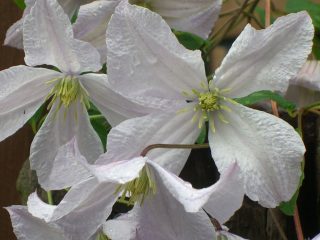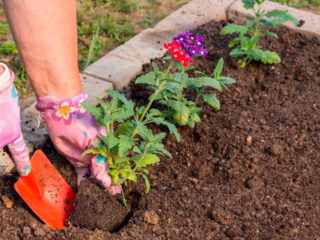Content
- 1 Origin story
- 2 Description of the William Shakespeare rose with photo
- 3 Advantages and disadvantages
- 4 Planting a Rose William Shakespeare
- 5 Rules for caring for roses William Shakespeare
- 6 Reproduction methods
- 7 Diseases and pests
- 8 Application in landscape design
- 9 Conclusion
- 10 Reviews of climbing rose William Shakespeare
Rose William Shakespeare is considered one of the most beautiful ornamental plants. This variety has gained enormous popularity among flower growers due to its luxurious double flowers of a crimson hue, delightful aroma and high resistance to adverse environmental factors.
Origin story
Rose William Shakespeare was bred by the famous British breeder David Austin in the late 80s. last century. As a result of crossing ancient European and hybrid tea varieties of modern selection, a variety appeared, called AUSroyal. For several years, work continued to increase the culture's resistance to disease, and in 2000 this rose was presented at an exhibition called William Shakespeare. The variety is considered the pearl of the collection of roses created by David Austin.
Description of the William Shakespeare rose with photo
The dense branched bush of the William Shakespeare rose reaches a height of 120 cm, its diameter is up to 100 cm.Under favorable climatic conditions, shoots can grow to almost 2 m.

The standard form of the William Shakespeare rose is less common than the bush form, but it looks just as impressive
The stems are densely covered with foliage from base to top. The leaves are medium-sized, oval-shaped with jagged edges and a sharp tip. The leaf plate is rich green, dense, matte.
During the season, the William Shakespeare rose goes through several flowering cycles. The buds appear at the very beginning of June, flowering ends in the first week of September, and under favorable climatic conditions, the active formation of inflorescences continues almost until October. Buds appear along the entire length of the shoots, making the bush distinguished by especially lush flowering. 3–5 flowers bloom on one peduncle.
The rosebud of this variety has a perfect spherical shape. A double cup-shaped flower blooms from it, which after a few days fully opens, becomes flat and acquires a bright purple hue. The diameter of the flower, formed by a large number of large petals of a velvety texture, reaches 12 cm. The William Shakespeare variety is very hardy. The flowers stay on the bush for 13–15 days.

The deep rich color of the English bush rose William Shakespeare, combined with the classic shape of the flower, gives the plant a special sophistication
The buds have a bright sweetish aroma, characteristic of this culture.
Winter hardiness of roses William Shakespeare
The variety has good winter hardiness. The flower tolerates temperatures down to -26°C, but in most parts of Russia it requires obligatory shelter for the winter.
Advantages and disadvantages
William Shakespeare roses are extremely popular due to their exceptional decorative qualities and relative ease of cultivation. Disease resistance greatly facilitates plant care.

A dense bush of William Shakespeare rose, strewn with crimson flowers, looks luxurious in any corner of the garden.
Advantages:
- outstanding decorative qualities;
- long flowering;
- frost resistance;
- immunity to the most common fungal diseases of the crop;
- relative unpretentiousness;
- ease of reproduction;
- wide possibilities of use in landscape design.
Flaws:
- the plant does not take root well in a new place when transplanted.
Planting a Rose William Shakespeare
When choosing a place for the William Shakespeare rose, you should take into account that the variety is characterized by rapid growth, the bush branches abundantly, so replanting an already rooted plant is difficult.
Areas with good lighting, protected from gusty winds, are suitable for this flower. It is advisable to provide the ability to protect the plantings from the midday sun so that the petals do not fade.
Stagnation of moisture is detrimental to the root system of the plant, so places with deep groundwater are chosen for it; it is better if the flower grows on a slight elevation to prevent waterlogging of the soil. The optimal substrate is well-drained chernozem or loamy soils with a slightly acidic reaction.
To prepare planting material, young shoots are harvested after the first flowering.

To obtain cuttings, shoots are cut at an acute angle and freed from leaves.
The stems are divided into segments so that 3–5 buds remain on each, then they are dropped in drops and covered with a transparent film. Like adult plants, they need insulation for the winter.
Purchased cuttings with a developed root system are planted from the third decade of April to mid-May in a pre-prepared hole with a nutrient substrate consisting of garden soil, rotted manure and wood ash. The seedlings are soaked in water with the addition of a growth stimulant for several hours, after which they are rooted at a depth of 5–6 cm, the soil is watered and mulched.
Rules for caring for roses William Shakespeare
Although English roses are relatively unpretentious, for the most spectacular flowering, the William Shakespeare variety requires some care. Roses require special attention in the first season after planting.
The plant must be watered weekly with warm, settled water, and during particularly hot periods, the soil should be moistened every three days in combination with spraying the foliage. At the same time as watering, weeds are removed and the soil is loosened.
To ensure high decorativeness of the bush throughout the season, the William Shakespeare rose is regularly fertilized. Fertilizing is applied in March and April, when the buds are laid, as well as in June-July, during the flowering period.
Despite the fact that the variety is immune to fungal diseases, preventive treatment of bushes with folk remedies or fungicides is recommended. It is carried out only on clear, dry days in the morning or evening.

Spraying bushes with fungicides protects against the development of fungal diseases for two weeks
When insect pests invade a flower, first destroy all affected parts of the plant, and then apply insecticides.
In the southern regions of the country, the William Shakespeare rose can winter without shelter, but in areas with cold winters the bushes must be protected from frost. The plant is prepared as follows:
- the remaining foliage, unripe shoots and faded buds are removed from the bush;
- adult stems are shortened by a quarter;
- the soil around is hilled up, mulched with sawdust or peat to a height of 30–40 cm and covered with spruce branches;
- in particularly harsh winters, the crop is additionally insulated with non-woven material.
Roses should not be allowed to overheat, so when a thaw occurs, it is necessary to ensure air access to the bush.
How to prune a Shakespeare rose
Like other varieties of this crop, William Shakespeare roses require pruning. In the spring, before the beginning of the growing season, it is necessary to remove all dry and damaged shoots. Weak branches are cut by half, strong branches by a third of their length. In summer, faded flowers are removed to encourage the formation of new buds. When preparing the plant for winter, the shoots are shortened by ¼ of the length.
Reproduction methods
William Shakespeare roses are propagated mainly by cuttings. Plants grown from seeds lose their varietal properties, and dividing the bush in most cases leads to its death.
Diseases and pests
The varietal feature of the William Shakespeare bush rose is its high resistance to powdery mildew, as well as black spot and rust, however, fungal diseases can still develop under unfavorable weather conditions.
Plantings can also be affected by insect pests, the most common of which are spider mites, thrips, aphids, roseate budworm and sawfly.
Application in landscape design
William Shakespeare's park rose is the main accent in all landscape compositions. It can be used in single plantings, or can be combined with many other plants, for example, sage, phlox, delphinium, and aconite. A rose looks impressive in the center of a flowerbed, surrounded by low-growing flowers: geraniums, bells, speedwell, phlox. Interesting compositions are obtained by combining roses with ground cover plants.
Due to the rapid growth and density of the bush, the William Shakespeare rose is suitable for a hedge.

If you carry out strong formative pruning, you can grow the crop in containers and flowerpots
Conclusion
Rose William Shakespeare is a luxurious flower that can decorate any garden. Its amazing beauty and nobility do not leave anyone indifferent. Flower growers often use this variety in landscape compositions; the William Shakespeare rose can be found in the most famous parks in the world.
Reviews of climbing rose William Shakespeare








